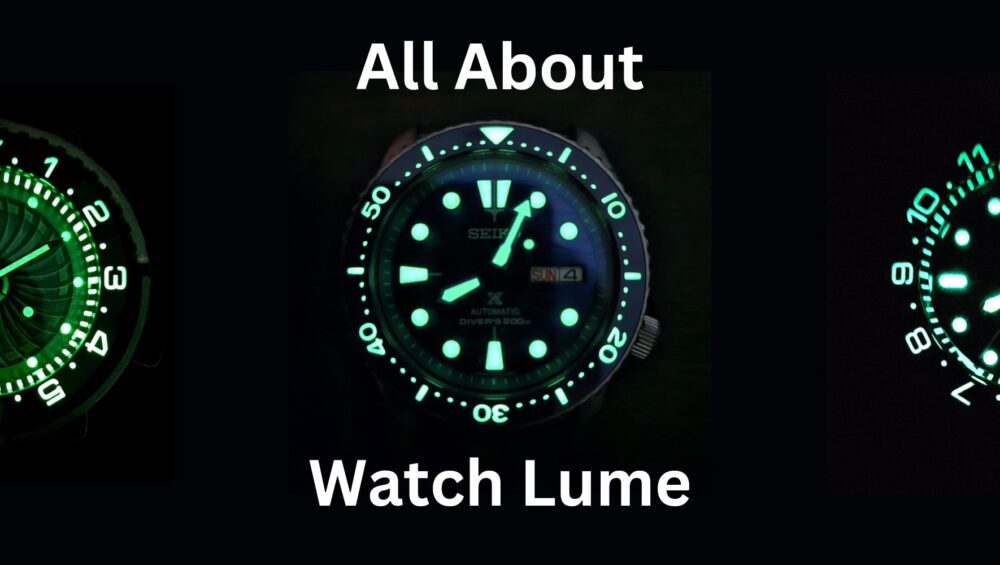LUMINESCENCE MAGIC: WATCH LUME
What is Watch Lume? When you were younger, I’m sure you wondered how some colors just glow in the dark. Now, as an adult, you will learn just how in this article all about watch lume!
The topic of luminous paint, often known as watch lume, will be covered in detail. Over time, watchmakers have used a variety of materials to create glowing components in watches, improving their usefulness at night. To help you better grasp how these hands, dials, bezel inserts and other components have been created, let’s go into some historical context.
A number of materials can be used to create the lume effect in a watch. Many different watch lume solutions have been tried out by the watch industry, some of which were quite risky! The kind of lume utilized and the amount of lume used both affect how long the watch lume will last. Some watchmakers use just one layer of lume, while others use many layers to make sure the watch not only glows brighter but also lasts longer.
A QUICK HISTORY OF LUME
Since the discovery of fire, people have been trying to find better and more advanced ways to see things in the dark. The end of the nineteenth century saw the invention of the contemporary wristwatch. The first few years after their creation, these watches were only worn by high-class, affluent women, as the gentlemen preferred the use of pocket watches, and by pilots, who used them to keep both hands free while flying.
Soldiers started donning wristwatches after the First World War so they wouldn’t have to remove a watch from their pocket to swiftly check the time when needed. The demand for high-end wristwatches rose globally as a result of this development. When troops wanted to know the time on the battlefield without having to strike a match or use a torch, watch lume became important. As more advanced glow-in-the-dark materials and methods have been developed since then, the effectiveness of watch luminescence has changed throughout the years.
LUME AND RADIOACTIVITY
Early on in their evolution, luminescent watches posed a threat. The original watch lume was produced using radium, which was dangerous for both the watch’s owner and the watchmakers who painted it onto the dials.
In the 1910s and 1920s, a working-class woman might make a respectable career by applying illuminating paint to watch dials. It evolved into a desirable position that required artistic aptitude. The innovative lume technique was state-of-the-art at the time, and workers enjoyed knowing that by creating readable watch dials for soldiers, they were aiding in the First World War effort. A precise brush used to apply the lume substance was often pointed with the tongue to maintain the bristles’ sharpness. It is also believed that employees had fun putting the phosphorescent substance into their fingernails, not knowing the dangers. Radium was the chemical in question; when mixed with zinc sulfide, it produced a dazzling light, which is phosphor.
Problems with Lume in the Early Days
Even while scientists and factory owners took safety procedures when handling larger amounts of radium, the working ladies were certain there wouldn’t be any negative consequences from the close contact with the chemical. It became clear that these females had been mistreated and neglected as their anemia, bone fractures, jaw necrosis, and finally when deaths started to manifest.
Grace Fryer and a group of female dial painters who went by the name of “Radium Girls” sued their employer, the United States Radium Corporation, in 1927. Due to this historical dispute, American employees now have better legal protection and are subject to stricter occupational safety regulations. Following that lawsuit, radium use was significantly decreased. The quantity of this substance used in watch displays had decreased by the 1960s to about one-tenth of what it had been in the early 1900s, and it was ultimately outlawed outright in 1968.
The Safer Switch
As a replacement, a brand-new radioactive element called tritium appeared. Tritium paint-based luminescence watches frequently use plastic tubes. Tritium dispersed and found its way into the dial, crystal, and case back, where it might have eventually reached the skin of the wearer. As a result, this invention had to be put into practice. Up until the early 1990s, tritium was largely superseded by two even safer substitutes that are still in use today, since it is far less radioactive than radium. Although tritium is now referred to as GTLS, or gaseous tritium light sources, several watch manufacturers, including Ball, Luminox, and Marathon, still employ it.
More impermeable than the paint on a dial that is just shielded by the watch glass, GTLS is carefully enclosed in incredibly small glass tubes. However, the manufacture of timepieces that use GTLS are prohibited in nations like Germany. Due to the fact that GTLS does not lose its brightness over time, unlike more contemporary varieties of lume, it is perfect for tool watches. After 24 years, with a half-life of around 12 years, only about 5% of the radioactive material is still present.
Tritium has been utilized in the past by a lot of watchmakers, including Rolex, the most renowned luxury watch brand. After tritium’s usage as a lume paint was banned in 1998, Rolex stopped using it. Since that time, Rolex has utilized its own kind of watch lume.
LumiNova Invention by Kenzo Nemoto
A Japanese man by the name of Kenzo Nemoto established a company in 1941 to sell phosphorescent paint. He was employed by the Japanese military during World War II to paint the gauges on airplanes and submarines. He had to look for new customers after the war because he was no longer painting for the military. Before turning to watches, Nemoto first made a living by painting the hands and hour marks on wall clocks.
Not long after the 1945 bombings of Hiroshima and Nagasaki, a Japanese businessman began considering how to create a new non-radioactive light material, at a time when the Japanese were growing more cautious about the risks of radioactive materials.
Nemoto established Nemoto & Co. in 1962 while creating a unique phosphorescent material, and by 1993, the company had supplied a brand-new kind of watch lume to the watchmaking industry. The brand-new material, strontium aluminate, is a ground-breaking, non-hazardous phosphor that is resistant to temperature changes, does not deteriorate over time, and is unaffected by environmental variables. In order to create LumiNova AG Switzerland, a division that would shortly provide the watch industry with “Super-Luminova” paint—the brand name for the shimmering substance—Nemoto teamed up with Swiss-based RC-Tritec AG* in 1998.
The formula for Luminova was developed by Nemoto, which he then marketed to watchmakers who wanted to take advantage of the newest glow-in-the-dark technology. Approximately 10 times brighter than the preceding lume, LumiNova was available in a range of hues, from vivid blue to bright green. Although it was discovered that the green color shone the brightest, the blue hue was found to shine the longest. This new substance needs to be combined with a chemical element called europium in order to shine. Unlike its predecessors, LumiNova improves nocturnal visibility by being “charged” when exposed to light, whether it be natural or artificial.
The LumiNova is comparable to a light-storage battery. The optimum charge is supposed to be from sunlight, while artificial light can also charge the lume. Light stimulates electrons, which then rapidly charge, when it hits phosphorescent material.
Photoluminescence
The watch lume pigments that employ photoluminescent elements like strontium aluminate or LumiNova are now the most popular. This material, which is painted onto hands, numerals, and dials, absorbs light and then emits it again in the dark, usually with a green or blue hue.
The drawback of Luminova is its shorter lifetime, which is often just around seven hours in the dark, which is significantly less than the annual timeframe that previous radioactive treatments provided. Although other watchmakers like Seiko and Rolex develop their own unique formulas, the Swiss business founded by Kenzo Nemoto and associates is currently among the top suppliers of photoluminescent paint.
Electroluminescence: Another Way to Go
Electroluminescence is the process of producing light as a result of an electrical current passing through a phosphor. A glass or plastic plate beneath the dial of a watch contains an electric conductor and phosphor. When a button is pressed, an electric current is sent, causing the phosphor to react and function as a backlight. The most well-known analog watch with this type of “backlight” lighting is the Indiglo from Timex. Despite the fact that it is more frequently seen in digital watches, as one of the few producers of analog watches using this type of lume, Timex obtained the patent for the invention in 1992.
The Exclusive Seiko Lume
Seiko divers with LumiBrite (also known as Lumi Brite) have spectacular brightness and may be purchased for a few hundred to several thousand dollars. The LumiNova technology created by Kenzo Nemoto serves as its foundation. The LumiBrite from Seiko is completely safe for both people and the environment because it doesn’t include any radioactive or poisonous materials. In order to emit light in the dark, LumiBrite is an improved luminous paint that quickly collects and stores light energy from the sun and other lighting sources.
Jiro Uchida, Seiko’s president, when LumiBrite was announced, stated that “LumiBrite is a virtually permanent, non-radioactive, fluorescent coating that can light up the face of a watch, or just its hands and numbers, for up to five hours after two minutes of exposure to sunlight.”
Seiko started using LumiBrite in 1994 as their in house watch lume. Timex IndiGlo watches and Seiko LumiBrite watches were also released at the same time. Notably, Seiko’s advertising campaign at the time emphasized that LumiBrite is “without buttons to press” and is 10 times brighter than LumiNova.
We provide aftermarket Seiko mod parts at Watch-Modz that are just as good as or better than OEM standards. Mod parts from Watch-Modz and other Seiko divers’ mod components are incredibly affordable and have excellent fit and finish. We have several different lumed hands, bezel inserts, and dials available. Watch-Modz uses C3 (green) and BGW9 (blue) Super-LumiNova, which is currently the brightest watch lume on the market.
In order to determine the brightness scale for photoluminescence colors, C3, which has a brightness of 100% in the grading system, is used as a benchmark. BGW9 is around 95% as bright as C3 when compared but can glow slightly longer. For instance, C3 Super-LumiNova® Lume is utilized on several of our SKX-style watch components.
You undoubtedly share our passion of lume if you enjoy diver’s watches. Visit our website Watch-Modz.com to browse a huge range of the world’s greatest Seiko aftermarket mod parts with the best watch lume!
About The Author

Pamela Tabago is an Information Specialist at Watch-Modz LLC. She is passionate about everything related to watches, from the best automatics to modding a Seiko.
She brings her data-driven experience in informative writing and her love for watches to the blog. She also provides watch-related content for other modding enthusiasts like herself.

